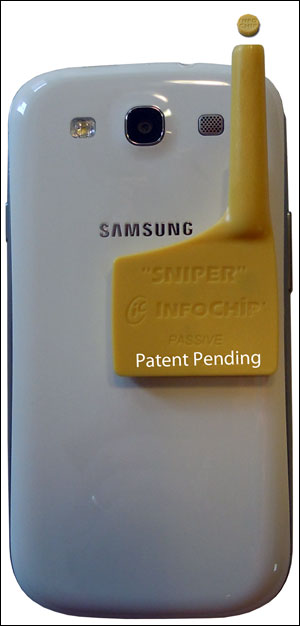Apr 22, 2013InfoChip Systems has developed a solution that it claims not only makes it possible to read very small high-frequency (HF) tags using standard off-the-shelf HF readers, but also enables that to be accomplished via a mobile phone. The solution that the company has developed—a small antenna adapter, known as the Sniper—attaches to the back of a mobile phone, or onto the back of a handheld reader. The device converts widely dispersed RF signals to focused ones as they are transmitted from the reader to the tag, thereby increasing the power level enough to enable a response from that tag.
The Sniper system could make it possible for tagged items to be read by anyone equipped with a Near Field Communication (NFC)-enabled phone, says Chris Gelowitz, InfoChip Systems' president and CEO, or via an HF 13.56 MHz handheld reader that could also have a Bluetooth connection to a laptop, phone or tablet.

InfoChip makes very small, rugged HF RFID tags complying with the ISO 15693 standard that are typically attached to metallic items for use in the field, such as lift equipment at oil and gas fields or construction sites. Tags have been getting smaller, the company reports. For example, the InfoChip HF DuraPlug initially measured 12 millimeters (0.47 inch). An 8-millimeter (0.31-inch) version was then released, and a 4-millimeter (0.16-inch) model is slated to debut later this year. The tags are designed to meet the needs of the most rugged use cases, according to InfoChip, and the majority of users (approximately 12 million of the company's tags have been sold since their release in 2007) are using them to track lifting equipment, such as shackles and hooks. The tags are embedded by being placed in a drilled hole within an asset, typically one-eighth of an inch deep.
Although the tag is small and durable, and the embedding process ensures that it is safe from damage or being knocked off an asset, it can also be difficult to read using a standard interrogator. InfoChip manufactures specialized readers that can accomplish the reads since they employ a very focused transmission. However, the company reports, in many cases, customers have standard off-the-shelf HF readers, such as products from Psion Teklogix, Ecom Instruments, Socket Mobile or Wireless Dynamics.
The Sniper, measuring 2 inches by 1.5 inches, can be attached to the back of a reader's antenna via a strip of 3M Dual-Lock fastener tape. The Sniper is a passive device, says Gelowitz, explaining that it does not require its own power source to operate. It converts a wide RF signal to a focused one, he says, similarly to how a funnel concentrates the flow of water. Gelowitz says he noticed one day that an NFC phone would also be able to interrogate the tags, provided that the transmission were focused with a Sniper device.
The company is now designing a way for the Sniper to be attached directly onto the protective cases that many consumers purchase for their phones. It can also be applied directly to the phone.
In June 2013, the company intends to release an application for the Android phone that would allow users to read a passive HF tag via an NFC-enabled mobile phone, send the data to a cloud-based server and, if authorized, read details about the tagged item based on the tag's ID number. They could also use the app to add their own data, such as inspection details or maintenance services provided.
InfoChip already provides software with its two HF readers (the Bluetooth Easy Reader and a USB reader called The Stick) to enable this function for those reading the InfoChip tags.
Currently, Gelowitz says, about 30 Sniper antenna adapters are being tested by InfoChip's customers. All are using them with handheld readers, he says, but in the future, he expects NFC-enabled phone users to acquire the Sniper along with the InfoChip app. He expects the NFC-enabled phone market to grow over the next year, and customers will increasingly want to allow personnel to utilize their phones to accomplish read events.
In March 2012, InfoChip released the pen-shaped Bluetooth Easy Reader that can be worn on an individual's belt (see RFID News Roundup: InfoChip's Tiny HF Bluetooth Reader, Embeddable UHF Tag). A year later, the company released a version for locations at which a risk of fire or explosion hazards may exist due to flammable gases, vapors, liquids or other combustible substances (see RFID News Roundup: InfoChip Unveils Bluetooth-enabled HF Reader for Hazardous Locations). The reader interrogates HF tags located as far as 4 centimeters (1.6 inches) away, including InfoChip's 8-millimeter (0.31-inch) DuraPlug tags embedded in metal, and forwards the data to a phone or computer device via a Bluetooth connection. The interrogator includes a small screen on which users can view the unique ID number encoded on the device.
InfoChip Systems will demonstrate the Sniper antenna adapter along with its other tag and reader products at RFID Journal LIVE! 2013, to be held from Apr. 30 to May 2 in Orlando, Fla. Gelowitz will be a presenter at two NFC Workshop preconference seminar sessions ("Innovative NFC Use Cases" and "NFC: A Profound Revolution in Asset Management"), as well as exhibiting products at InfoChip's booth (#343).


